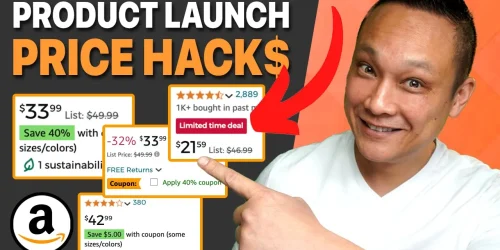You Will Rank On Page 1 with NEW Amazon Keyword Strategy
In the world of Amazon selling, there’s a common belief that high search volume keywords are the golden ticket to success. But what if I told you that chasing high search volume keywords could actually hinder your ability to rank organically and drain your PPC budget? In this post, I’ll show you a revolutionary Amazon keyword strategy that focuses on high-conversion keywords, helping you rank faster, save on ad spend, and ultimately boost your sales.
The Misconception: Search Volume vs. Sales Volume
When you search for a product on Amazon, the listings that appear are not placed there randomly. Ignoring the sponsored listings at the top, the first organic listing typically belongs to the best seller, the second to the second best seller, and so on. This ranking is based on sales volume rather than search volume.
Example Breakdown
Let’s say you’re selling tent stakes. Consider these two keywords:
- Keyword 1: “10 stakes” – 50,000 searches/month
- Keyword 2: “stakes for camping” – 299 searches/month
At first glance, “10 stakes” seems like the obvious choice due to its massive search volume. But when we look at the conversion rates, the story changes:
- “10 stakes”: 6% conversion rate (6 sales per 100 searches)
- “stakes for camping”: 52% conversion rate (52 sales per 100 searches)
Despite the lower search volume, “stakes for camping” generates significantly more sales per search. This is the power of focusing on conversion rate over search volume.
Why High-Conversion Keywords Are the Key to Success
Amazon’s search algorithm prioritizes listings that convert well, meaning that the more sales your listing generates, the higher it will rank. High search volume keywords might attract clicks, but if they don’t convert into sales, they won’t help you rank. Worse, they can lead to wasted ad spend as you pay for clicks that don’t result in sales.
The Impact on PPC
If you’re bidding on high search volume keywords with low conversion rates, your PPC campaigns will likely suffer. You’ll spend more on clicks without seeing a corresponding increase in sales, eating into your profits.
Case Study: Screw-in Camping Tent Stakes
Let’s say you’re selling screw-in camping tent stakes. Here’s how the keywords break down:
| Keyword Type | Average Search Volume | Average Conversion Rate | CPR (Units to Rank on Page 1) |
|---|---|---|---|
| High Search Volume | 25,000 | 15% | 50 units |
| High Conversion (Sales Volume) | 1,000 | 26% | 13 units |
As you can see, to rank on the first page for high search volume keywords, you’d need to sell 50 units, whereas for high-conversion keywords, you’d only need to sell 13 units. This approach not only helps you rank faster but also at a lower cost.
How to Find High-Conversion Keywords
To implement this strategy, you need a powerful keyword research tool that prioritizes sales volume over search volume. I recommend using Sellerize’s Keyword Hunter Pro. Here’s how you can use it:
Step 1: Generate a List of Relevant Keywords
Start by entering a seed keyword, such as “camping tent stakes.” Keyword Hunter Pro will generate a list of relevant keywords, showing you how many sales each keyword has generated.
Step 2: Filter the Keywords
To refine your keyword list:
- Remove Low-Conversion Keywords: Filter out keywords with a conversion rate below 20%.
- Check Market Availability: Keep keywords where the top three sellers capture less than 60% of the total sales. This indicates that the market is not overly saturated, giving you a better chance to capture sales.
Step 3: Analyze and Download Your Keyword List
After applying these filters, download your refined list of high-conversion keywords. In Excel or Numbers, further narrow down the list by:
- Removing Keywords with Low Sales: Remove keywords that generate less than 25 sales per month.
- Eliminating Irrelevant Keywords: Sort by relevance and remove keywords that aren’t directly related to your product.
Step 4: Spy on Competitors
Next, check out the top three competitors in your niche. Use Keyword Hunter Pro to extract their best-performing keywords and compare them with your list. Remove any duplicates, and once again, filter out low-conversion and irrelevant keywords.
Step 5: Finalize Your Keyword List
Lastly, search each keyword phrase on Amazon to ensure they’re a good match for your product. Highlight any keywords that pull up unrelated products and separate them into two groups:
- Group 1: Keywords to use in your product listing and PPC campaigns.
- Group 2: Keywords to use only for keyword indexing.
Conclusion
By focusing on high-conversion keywords instead of high search volume, you can rank faster, save on PPC costs, and ultimately increase your sales. This strategy leverages Amazon’s sales-driven ranking algorithm to your advantage, helping you outperform competitors who are still fixated on search volume.
If you want to try out Sellerize’s Keyword Hunter Pro for yourself, I’ve included a free trial and a discount link:
Sellerise 10% Off Coupon: https://go.crescentkao.com/sellerise
Tables and Lists Recap
- Table Example: Comparison of keyword types based on search volume, conversion rate, and units needed to rank on page 1.
- Step-by-Step List: A guide to filtering and finalizing your high-conversion keyword list.
With this advanced keyword strategy, you’re well on your way to dominating your niche on Amazon.






